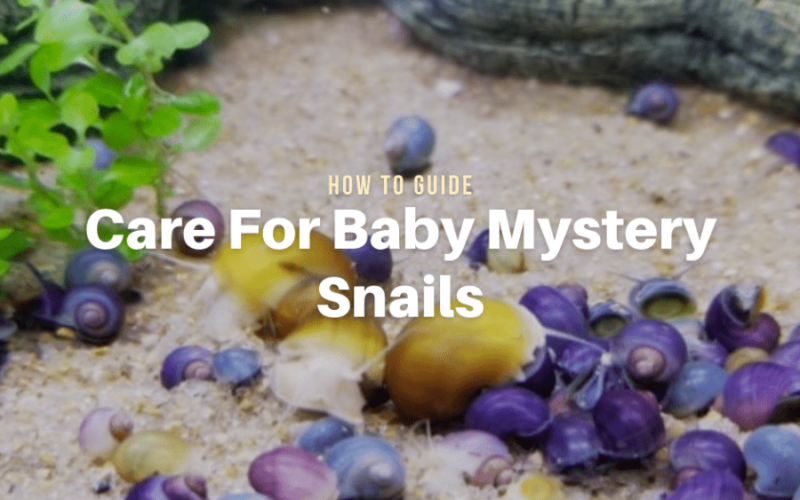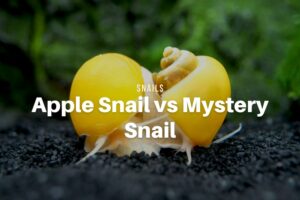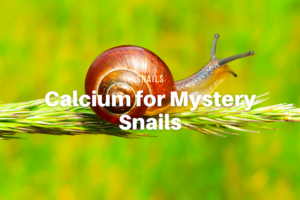Mystery snails are tiny aquarium creatures with cute shells on top. Also known as apple snails or golden apple snails, it becomes a new favorite among breeders.
Thankfully, growing baby mystery snails is quite simple but it requires knowledge and a little know-how.
The aquarium is a great place to breed mystery snails, but it is important to use a dedicated, separate tank for these little snails.
If you insist to put some larger fish in the same tank, that means you can say goodbye to the snails—that is because fishes can be a predator to mystery snails.
“How to breed mystery snails in an aquarium? How fast they can grow and what colors can they be?“
If you are new to snail breeding then you have a lot to learn. Read on and find a useful guide to care for newly hatched mystery snail babies.
How to Care For Baby Mystery Snails
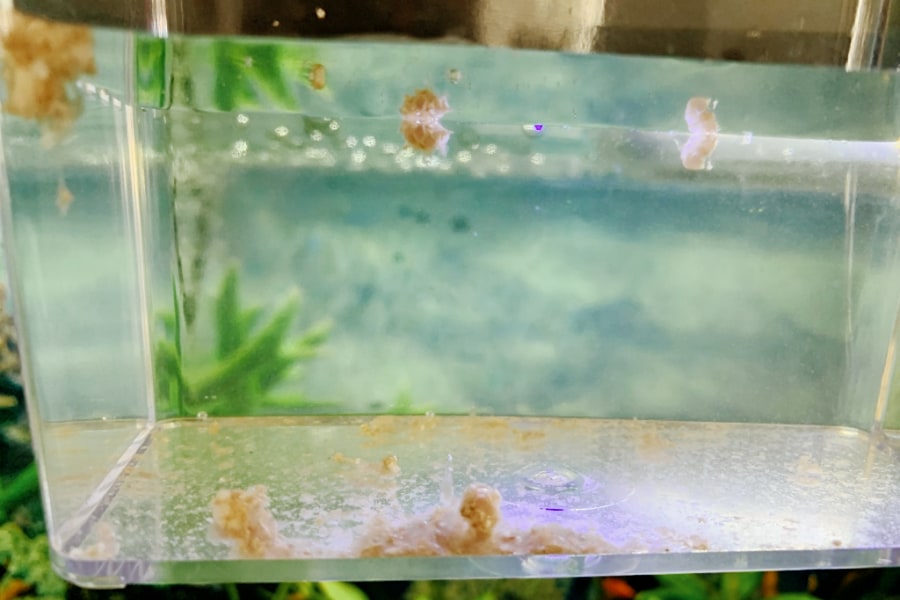
Caring for baby snails can be challenging, but everything becomes a lot simpler if you know the trick. There are several aspects to take into consideration, just to make sure your baby snails grow healthy and happy in the fish tank.
Here are things you need to know about caring for baby snails:
Water Temperature
Snail eggs hatch at the proper temperature. This means without proper temperature, mystery snail eggs are unlikely to hatch and even the eggs can’t survive.
It becomes necessary to monitor the water and ensure that the water temperature is between 68 F and 84 F for healthy young snails.
Food
Mystery snail babies don’t need special food as they eat the same things as their parents do, even from their first day.
These aquatic snails feed on aquatic plants and vegetation that become their main diets. It is also important to provide algae for added benefits.
To encourage baby snails to move in the tank, you can place the food in a different place so they have to move around for food. You may also need to add a calcium-rich diet so the babies can develop stronger shells.
Water Condition
When you plan to care for mystery snail babies, it becomes necessary to maintain healthy water conditions.
Mystery snails don’t like sudden changes in water condition, therefore it is best to monitor the condition of tank water.
Regularly monitor the pH level and it should be between 7.6 and 8.4. It is also important to check water hardness that should be somewhere between 12 and 18kH.
You may need a special tool to quickly test water conditions.
Remove Uneaten Food
Another thing you need to know when caring for aquatic apple snails is to remove any uneaten food.
You may feed them sliced veggies like carrot, cucumber, or kale but always remember to remove the leftover. The remaining food will become moldy over time and it will transform into waste.
When to Transfer
Depending on the water temperature, it takes around 9 days to 5 weeks for eggs to hatch. When they hatch, mystery snail babies are about the same size as a sesame seed and they look gray.
Instantly after the babies are hatched, they will eat the shell fragments until it’s completely gone.
How long should you wait before moving baby mystery snails? Young mystery snails can be transferred to a larger tank after they get their first meal. They should be the size of a pea before they are ready for a new home.
If you plan to transfer them to a fish tank, make sure the fishes are not large enough to eat the snails. But it is highly recommended to use a separate tank.
5 Amazing Facts about Mystery Snails
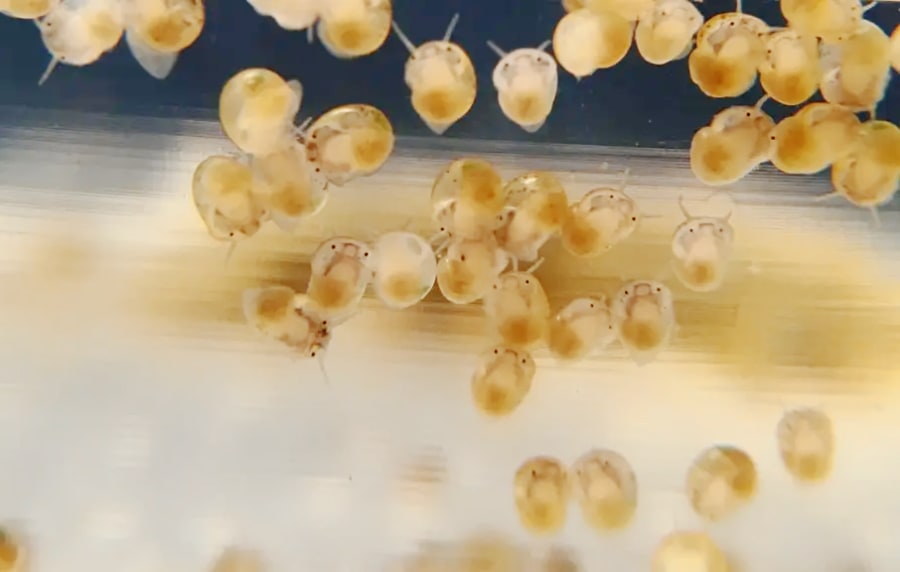
Now that you know how to care for aquatic mystery snails, you may be interested to figure out mind-blowing facts about these snails. Whether you are a new snail breeder or hobbyist, here are 5 amazing facts about mystery snails nobody told you before:
1. Grow Rapidly
How fast do baby mystery snails grow? This is a common question among new breeders but the answer is quite simple. After the eggs hatched, mystery snail babies grow quickly.
They are about the size of a sesame seed on the first day they hatched but they will be at a size of one inch in 2 to 5 months.
If you want to see them grow in size quickly, it becomes necessary to feed them well. With a proper diet, your mystery snails can double in size in a matter of weeks.
2. Colorful Aquatic Snails
Mystery snail babies get their first color about 3 days after they hatched and it is rather difficult to tell the final color until it ages 10 days. But some snails show their real color about 2 weeks after they hatched.
There are different colors of baby mystery snails, you can find on the market, such as yellow, purple, white, and green.
But some snails come in rare colors like jade or wild colors, which take around 2 months for them to appear.
3. Mystery Snails Don’t Eat Their Babies
Some people might tell you that mystery snails eat their babies. It’s nothing more than just a myth. Mystery snails don’t eat their babies, so it is safe enough to put newly hatched snail babies in the same tank as their parents.
Just in case your baby snail disappears from the tank, it doesn’t mean the parents have eaten it. You may want to double-check the tank because of its tiny size.
4. Breath Through Gills and Tube
Mystery snails have a unique breathing technique as they can breathe through their gills and a tube. While the gills help them breathe in the water, the tube allows them to breathe fresh air.
That becomes the question is, how do baby mystery snails breathe air?
When they are underwater, mystery snails will move to the water surface and extend their tube up beyond the waterline.
The tube is then moved back and forth to allow fresh air in. This is the main source of oxygen needed for their metabolism.
5. Sensitive to Copper
Not least of all, it’s important to note that mystery snails are sensitive to copper. It is highly advisable to monitor the level of copper in your tank, especially if you use tap water.
Regularly check water conditions to make sure the snails can grow healthy and happy.
Caring for baby mystery snails isn’t tricky but there are some points to take into consideration. Pretty much like other animals, these snails need special care to develop properly.
If you are interested to grow or breed mystery snails, make sure you have learned anything about this aquatic snail.
